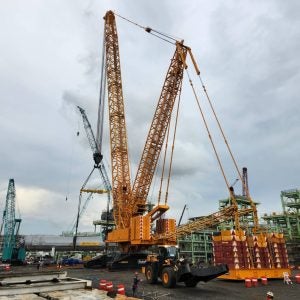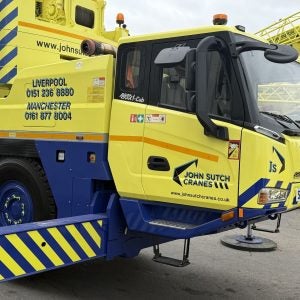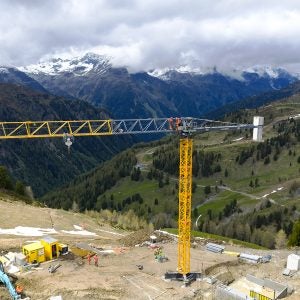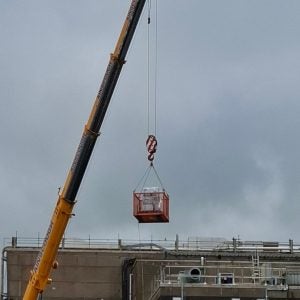The Vestas Tower Crane (VTC) has been designed to attach directly to the mast and climb the tower to carry out maintenance work on essential components, including the hub, gearbox, generator and blades.
As it moves up the mast, it is capable of carrying loads weighing up to 30t. It offers a number of operational benefits over traditional methods of maintenance and repair carried out with mobile or crawler cranes, said Anders Vedel, senior vice president of technology R&D at Vestas.
“As wind turbines are getting bigger it is a bigger challenge to get cranes on site,” Vedel said. “And bigger turbines also means there are fewer cranes that are capable of doing the work.
“Maybe eight years ago there were many cranes capable of doing the work but as the turbines have got bigger you have needed bigger cranes.”
Wind movement is another issue that Vestas has sought to overcome with the VTC. “Crawler and mobile cranes positioned next to the turbine move differently. The tower crane moves with the turbine so it is safer.”
Figures published by Vestas in its own literature said the VTC can operate in wind speeds up to 17m/min and remain safely attached to the mast in speeds up to 28m/min. This, the article reads, compares to safe operating in wind speeds up to 10-12m/min for regular cranes.
Vedel would not confirm these figures but said: “We do expect that we can operate in higher wind speeds, although the numbers still need to be assessed and verified.”
These tests, and others on the reliability and safety of the technology, are nearing completion and will allow Vestas to move on with the next phase of VTC’s development.
The first version has been designed for use on its 3MW wind turbines and Vedel said Vestas will now “optimise and modulise” the technology.
“There is a target that it will be available for use on all turbines. There will be adaptations so it can be used on other turbine sizes.”
Vestas is also considering employing the VTC during the installation process. “We are considering using it as part of the installation process,” Vedel said.
“Some parts are too heavy for it to install so a main crane will be used to stack the mast and place the nacelle. The VTC can then be used to install other components.”
Scotland-based ITI Energy has been carrying out R&D work on a similar ‘no crane’ system to the VTC for two years. Its wind turbine access system, Orangutan, will also provide a work platform but with additional clamping technology to climb standard towers carrying components to the summit, avoiding the cost of winches, auxiliary cranes and turbine modifications.
“Wind farms are often sited on remote hill-top locations, that can be difficult to access. Heavy cranes can cause substantial damage to the ground and access roads,” ITI Energy has said. “Large cranes are inherently costly, and difficult to transport, deploy, operate and demobilise. In addition, they can only be deployed in low-level wind conditions.”
Orangutan has undergone extensive testing on a range of issues, including the impact of pressing rubber pads on a painted surface, the loads that can be hung from friction clamps and the loads that can safely hang from a turbine, to ensure all the bases have been covered in terms of crane certification and health and safety before a prototype is developed.
The research has been funded by Scottish Enterprise, which David Slee, programme manager for the wind turbine access system at ITI Energy, said has made the company “reluctant to say what it can and can’t do in public until our latest patent applications are published.
“We’ve done a lot of research into various aspects of the technology,” he said. “We have a prototype design and can now enable organisations to test that it works on a full-scale model.”
Slee said the development of the technology falls in line with the wind power sector coming of age, and the need for maintenance and repair work as turbines move out of warranty. This will allow businesses offering this service to emerge.
“There is a burning need from the energy market to reduce the cost of maintenance and repair. This is an enabling technology that allows a new business type to emerge and we are looking for licensees and developers with that in mind.”
Vedel said the development of the VTC would allow Vestas to improve its own customer offering and provide a better service.
“Vestas is looking for opportunities to make a difference. Offering customers a good service is a priority. To increase the availability of cranes and reduce the time it takes to get them to site is good for customers and Vestas,” continued Vedel.
“Vestas offers customers a long-term service agreement. The tower crane is a tool that enables us to provide a better service. Being more in charge of that part of the supply chain seems like a good idea.”






